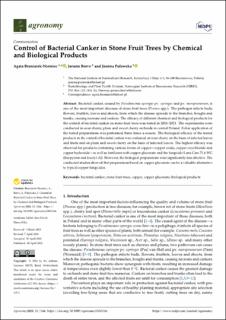Control of Bacterial Canker in Stone Fruit Trees by Chemical and Biological Products
| dc.contributor.author | Broniarek-Niemiec, Agata | |
| dc.contributor.author | Børve, Jorunn | |
| dc.contributor.author | Puławska, Joanna | |
| dc.date.accessioned | 2023-08-01T08:50:26Z | |
| dc.date.available | 2023-08-01T08:50:26Z | |
| dc.date.created | 2023-05-15T15:42:52Z | |
| dc.date.issued | 2023-04-20 | |
| dc.identifier.issn | 2073-4395 | |
| dc.identifier.uri | https://hdl.handle.net/11250/3082068 | |
| dc.description.abstract | Bacterial canker, caused by Pseudomonas syringae pv. syringae and pv. morsprunorum, is one of the most important diseases of stone fruit trees (Prunus spp.). The pathogen infects buds, flowers, fruitlets, leaves and shoots, from which the disease spreads to the branches, boughs and trunks, causing necrosis and cankers. The efficacy of different chemical and biological products for the control of bacterial canker on stone fruit trees was tested in 2018–2021. The experiments were conducted in sour cherry, plum and sweet cherry orchards in central Poland. Foliar application of the tested preparations was performed three times a season. The biological efficacy of the tested products in the control of bacterial canker was evaluated on sour cherry on the basis of infected leaves and fruits and on plum and sweet cherry on the basis of infected leaves. The highest efficacy was observed for products containing various forms of copper—copper oxide, copper oxychloride and copper hydroxide—as well as fertilizers with copper gluconate and the fungicide Luna Care 71.6 WG (fluopyram and fosetyl-Al). However, the biological preparations were significantly less effective. The conducted studies showed that preparations based on copper gluconate can be a valuable alternative to typical copper fungicides. | en_US |
| dc.language.iso | eng | en_US |
| dc.publisher | MDPI | en_US |
| dc.title | Control of Bacterial Canker in Stone Fruit Trees by Chemical and Biological Products | en_US |
| dc.title.alternative | Control of Bacterial Canker in Stone Fruit Trees by Chemical and Biological Products | en_US |
| dc.type | Peer reviewed | en_US |
| dc.type | Journal article | en_US |
| dc.description.version | publishedVersion | en_US |
| dc.rights.holder | © 2023 by the authors | en_US |
| dc.source.volume | 13 | en_US |
| dc.source.journal | Agronomy | en_US |
| dc.source.issue | 4 | en_US |
| dc.identifier.doi | 10.3390/agronomy13041166 | |
| dc.identifier.cristin | 2147663 | |
| dc.relation.project | Norges forskningsråd: 282257 | en_US |
| dc.source.articlenumber | 1166 | en_US |
| cristin.ispublished | true | |
| cristin.fulltext | original | |
| cristin.qualitycode | 1 |
Tilhørende fil(er)
Denne innførselen finnes i følgende samling(er)
-
Divisjon for bioteknologi og plantehelse [532]
Publikasjoner knyttet til ansatte ved Divisjon for bioteknologi og plantehelse -
Publikasjoner fra CRIStin - NIBIO [4575]
-
Vitenskapelige artikler [1416]
